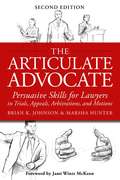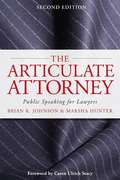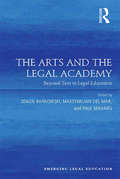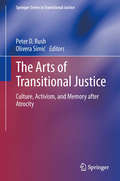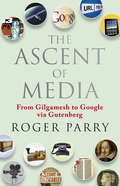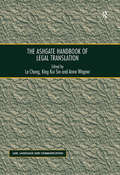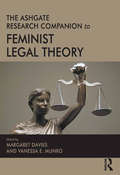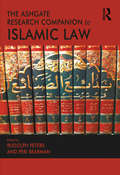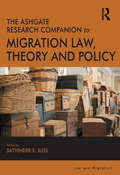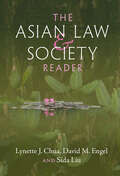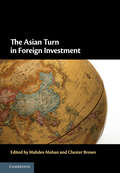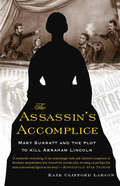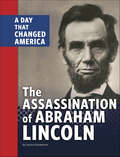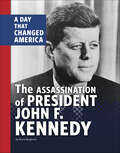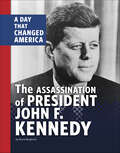- Table View
- List View
The Articulate Advocate: Persuasive Skills for Lawyers in Trials, Appeals, Arbitrations, and Motions
by Brian K. Johnson Marsha Hunter Jami McKeon Barbara RichiedAn advocate may know what to say but is only effective when he or she knows how to be persuasive. Combining fact with know-how to persuade judges, juries, and arbitrator, the book teaches immediately useful techniques such as how to channel the initial adrenaline buzz, grab and hold the fact finder's attention, gesture while speaking, speaking in phrases, and polishing the persuasive style. Based on 25 years of experience from coaching practitioners, this guide integrates cutting edge discoveries in human factors, gesture studies, linguistics, neuroscience, and sports psychology to give litigators a competitive edge. This brand new edition includes all new illustrations and new information on motions, arbitrations, and appeals.
The Articulate Attorney: Public Speaking For Lawyers
by Brian Johnson Marsha Hunter Caren StacyAddressing the distinctive communication skills expected of attorneys--and based on three decades of experience coaching lawyers--this manual of practical, useful solutions integrates cutting-edge discoveries in human factors, linguistics, neuroscience, gesture studies, and sports psychology. These techniques will transform any attorney into a more confident speaker, whether addressing colleagues in a conference room, counseling clients in a boardroom, or presenting a CLE in a ballroom. Including tips on bringing the presentation off of one's notes and using direct eye contact, the book answers such common questions as: How do I channel nervous energy into dynamic delivery? What is a reliable way to remember what I want to say? How do I stop saying "um" and think in silence instead? and Why is gesturing so important? Topics are divided into chapters on the body, the brain, and the voice, with an extra section specifically dedicated to practice.
The Arts and the Legal Academy: Beyond Text in Legal Education (Emerging Legal Education)
by Maksymilian Del Mar Paul Maharg Zenon BańkowskiIn Western culture, law is dominated by textual representation. Lawyers, academics and law students live and work in a textual world where the written word is law and law is interpreted largely within written and printed discourse. Is it possible, however, to understand and learn law differently? Could modes of knowing, feeling, memory and expectation commonly present in the Arts enable a deeper understanding of law's discourse and practice? If so, how might that work for students, lawyers and academics in the classroom, and in continuing professional development? Bringing together scholars, legal practitioners internationally from the fields of legal education, legal theory, theatre, architecture, visual and movement arts, this book is evidence of how the Arts can powerfully revitalize the theory and practice of legal education. Through discussion of theory and practice in the humanities and Arts, linked to practical examples of radical interventions, the chapters reveal how the Arts can transform educational practice and our view of its place in legal practice. Available in enhanced electronic format, the book complements The Moral Imagination and the Legal Life, also published by Ashgate.
The Arts of Transitional Justice
by Olivera Simić Peter D. RushThe Art of Transitional Justice examines the relationship between transitional justice and the practices of art associatedwith it. Art, which includes theater, literature, photography, and film, hasbeen integral to the understanding of the issues faced in situations oftransitional justice as well as other issues arising out ofconflict and mass atrocity. The chapters in this volume take up this understandingand its demands of transitional justice in situations in several countries:Afghanistan, Serbia, Srebenica, Rwanda, Northern Ireland, Cambodia, as well asthe experiences of resulting diasporic communities. In doing so, it brings tobear the insights from scholars, civil society groups, and art practitioners,as well as interdisciplinary collaborations.
The Ascent of Media
by Roger ParryThe Ascent of Media tells the whole story of media from its earliest incarnation in the clay tablets of Gilgamesh, through the Gutenberg press, right up to Google and the unfurling world of digital content. The Ascent of Media is a narrative history of the media in its every form, from theatre to posters to video games, and told with a host of fascinating fact and anecdote. Opening up a whole new forum for debate, Parry argues that contemporary media is not, as the doomsayers suggest, in decline, but on the cusp of a new era - one in which it will adapt, evolve and thrive. History teaches us that media cannot and do not die. This is a startling account of the mediums that inform us, shape us, move us and make us, and a rallying call to innovators of the future.
The Ashgate Handbook of Legal Translation (Law, Language and Communication)
by Le Cheng King Kui SinThis volume investigates advances in the field of legal translation both from a theoretical and practical perspective, with professional and academic insights from leading experts in the field. Part I of the collection focuses on the exploration of legal translatability from a theoretical angle. Covering fundamental issues such as equivalence in legal translation, approaches to legal translation and the interaction between judicial interpretation and legal translation, the authors offer contributions from philosophical, rhetorical, terminological and lexicographical perspectives. Part II focuses on the analysis of legal translation from a practical perspective among different jurisdictions such as China, the EU and Japan, offering multiple and pluralistic viewpoints. This book presents a collection of studies in legal translation which not only provide the latest international research findings among academics and practitioners, but also furnish us with a new approach to, and new insights into, the phenomena and nature of legal translation and legal transfer. The collection provides an invaluable reference for researchers, practitioners, academics and students specialising in law and legal translation, philosophy, sociology, linguistics and semiotics.
The Ashgate Research Companion to Feminist Legal Theory
by Vanessa E. MunroAs a distinct scholarly contribution to law, feminist legal theory is now well over three decades old. Those three decades have seen consolidation and renewal of its central concerns as well as remarkable growth, dynamism and change. This Companion celebrates the strength of feminist legal thought, which is manifested in this dynamic combination of stability and change, as well as in the diversity of perspectives and methodologies, and the extensive range of subject-matters, which are now included within its ambit. Bringing together contributors from across a range of jurisdictions and legal traditions, the book provides a concise but critical review of existing theory in relation to the core issues or concepts that have animated, and continue to animate, feminism. It provides an authoritative and scholarly review of contemporary feminist legal thought, and seeks to contribute to the ongoing development of some of its new approaches, perspectives, and subject-matters. The Companion is divided into three parts, dealing with 'Theory', 'Concepts' and 'Issues'. The first part addresses theoretical questions which are of significance to law, but which also connect to feminist theory at the broadest and most interdisciplinary level. The second part also draws on general feminist theory, but with a more specific focus on debates about equality and difference, race, culture, religion, and sexuality. The 'Issues' section considers in detail more specific areas of substantive legal controversy.
The Ashgate Research Companion to International Criminal Law: Critical Perspectives
by Yvonne McDermottInternational criminal law is at a crucial point in its history and development, and the time is right for practitioners, academics and students to take stock of the lessons learnt from the past fifteen years, as the international community moves towards an increasingly uni-polar international criminal legal order, with the International Criminal Court (ICC) at the helm. This unique Research Companion takes a critical approach to a wide variety of theoretical, practical, legal and policy issues surrounding and underpinning the operation of international criminal law as applied by international criminal tribunals. The book is divided into four main parts. The first part analyses international crimes and modes of liability, with a view to identifying areas which have been inconsistently or misguidedly interpreted, overlooked to date or are likely to be increasingly significant in future. The second part examines international criminal processes and procedures, and here the authors discuss issues such as victim participation and the rights of the accused. The third part is a discussion of complementarity and sentencing, while the final part of the book looks at international criminal justice in context. The authors raise issues which are likely to provide the most significant challenges and most promising opportunities for the continuing development of this body of law. As international criminal law becomes more established as a distinct discipline, it becomes imperative for international criminal scholarship to provide a degree of critical analysis, both of individual legal issues and of the international criminal project as a whole. This book represents an important collective effort to introduce an element of legal realism or critical legal studies into the academic discourse.
The Ashgate Research Companion to Islamic Law
by Peri BearmanThis unparalleled Companion provides a comprehensive and authoritative guide to Islamic law to all with an interest in this increasingly relevant and developing field. The volume presents classical Islamic law through a historiographical introduction to and analysis of Western scholarship, while key debates about hot-button issues in modern-day circumstances are also addressed. In twenty-one chapters, distinguished authors offer an overview of their particular specialty, reflect on past and current thinking, and point to directions for future research. The Companion is divided into four parts. The first offers an introduction to the history of Islamic law as well as a discussion of how Western scholarship and historiography have evolved over time. The second part delves into the substance of Islamic law. Legal rules for the areas of legal status, family law, socio-economic justice, penal law, constitutional authority, and the law of war are all discussed in this section. Part three examines the adaptation of Islamic law in light of colonialism and the modern nation state as well as the subsequent re-Islamization of national legal systems. The final section presents contemporary debates on the role of Islamic law in areas such as finance, the diaspora, modern governance, and medical ethics, and the volume concludes by questioning the role of Sharia law as a legal authority in the modern context. By outlining the history of Islamic law through a linear study of research, this collection is unique in its examination of past and present scholarship and the lessons we can draw from this for the future. It introduces scholars and students to the challenges posed in the past, to the magnitude of milestones that were achieved in the reinterpretation and revision of established ideas, and ultimately to a thorough conceptual understanding of Islamic law.
The Ashgate Research Companion to Migration Law, Theory and Policy (Law and Migration)
by Satvinder S. JussThe Ashgate Research Companion to Migration Law, Theory and Policy complements the already successful Ashgate series Law & Migration, established in 2006 which now has a number of well-regarded monographs to its credit. The purpose of this Companion is to augment that Series, by taking stock of the current state of literature on migration law, theory and policy, and to sketch out the contours of its future long-term development, in what is now a vastly expanded research agenda. The Companion provides readers with a definitive and dependable state-of-art review of current research in each of the chosen areas that is all-embracing and all-inclusive of its subject-matter. The chapters focus on the regional and the sub-regional, as well as the national and the global. In so doing, they aim to give a snap-shot that is contextual, coherent, and comprehensive. The contributors are both world-renowned scholars and newer voices and include scholars, practitioners, former judges and researchers and policy-makers who are currently working for international organisations.
The Asian Law and Society Reader
by David M. Engel Sida Liu Lynette J. ChuaThe first reader on Asian law and society scholarship, this book features reading selections from a wide range of Asian countries – East, South, Southeast and Central Asia – along with original commentaries by the three editors on the theoretical debates and research methods pertinent to the discipline. Organized by themes and topical areas, the reader enables scholars and students to break out of country-specific silos to make theoretical connections across national borders. It meets a growing demand for law and society materials in institutions and universities in Asia and around the world. It is written at a level accessible to advanced undergraduate students and graduate students as well as experienced researchers, and serves as a valuable teaching tool for courses focused on Asian law and society in law schools, area studies, history, religion, and social science fields such as sociology, anthropology, politics, government, and criminal justice.
The Asian Turn in Foreign Investment
by Chester Brown Mahdev MohanThis collection critically discusses the increasing significance of Asian States in the field of international investment law and policy. Consisting of contributions authored by a leading team of scholars and practitioners of international investment law, this volume contains analyses of both national and multilateral investment law rule-making in Asia, including a critical discussion of certain States' approaches to balancing the different tension between investment protection and the preservation of States' regulatory sovereignty. It also contains thematic chapters on cutting-edge developments which are of relevance to Asia as well as the global community, such as investors' obligations of due diligence, additional transparency in treaty-based investment arbitration responses by ASEAN member States to transboundary haze pollution, and the relevance of human rights obligations in international investment law. It also contemplates future possibilities for investor-State dispute settlement, including the use of investor-State mediation in view of the Singapore Convention on Mediation.
The Assassin's Accomplice
by Kate Clifford LarsonSet against the backdrop of the Civil War, The Assassin’s Accomplice tells the gripping story of the conspiracy to assassinate Abraham Lincoln through experience of its only female participant. Confederate sympathizer Mary Surratt ran a boarding house in Washington, and the depth of her complicity in the murder of President Lincoln has been debated since she was arrested on April 17, 1865. Calling upon long-lost interviews, confessions, and court testimony, historian Kate Clifford Larson magnificently captures how Surratt’s actions defied nineteenth-century norms of piety and allegiance. A riveting account of espionage and murder, The Assassin’s Accomplice offers a revealing examination of America’s most remembered assassination.
The Assassination of Abraham Lincoln (A Day That Changed America)
by Jessica GundersonOn April 14, 1865, only days after the Civil War had come to a close, a gunshot rang out in Ford’s Theatre and President Abraham Lincoln slumped forward in his seat. Hours later, the United States had lost its leader. Now readers can step back in time to learn about what led up to the assassination plot, how the fateful evening unfolded, and the ways in which one tragic day changed America forever.
The Assassination of Abraham Lincoln (A Day That Changed America)
by Jessica GundersonOn April 14, 1865, only days after the Civil War had come to a close, a gunshot rang out in Ford’s Theatre and President Abraham Lincoln slumped forward in his seat. Hours later, the United States had lost its leader. Now readers can step back in time to learn about what led up to the assassination plot, how the fateful evening unfolded, and the ways in which one tragic day changed America forever.
The Assassination of President John F. Kennedy (A Day That Changed America)
by Bruce BerglundPresident John F. Kennedy was a popular president. On November 22, 1963, he waved to excited crowds from the back of a car as it wound through the streets of Dallas, Texas. Suddenly, gunshots rang out. The president had been shot! He died shortly after. The country had lost its leader. Now readers can step back in time to learn about what led up to the assassination, how the fateful day unfolded, and the ways in which one shocking day changed America forever.
The Assassination of President John F. Kennedy (A Day That Changed America)
by Bruce BerglundPresident John F. Kennedy was a popular president. On November 22, 1963, he waved to excited crowds from the back of a car as it wound through the streets of Dallas, Texas. Suddenly, gunshots rang out. The president had been shot! He died shortly after. The country had lost its leader. Now readers can step back in time to learn about what led up to the assassination, how the fateful day unfolded, and the ways in which one shocking day changed America forever.
The Assassination of President John F. Kennedy: A Day that Changed America (Days That Changed America)
by Bruce BerglundPresident John F. Kennedy was a popular president. On November 22, 1963, he waved to excited crowds from the back of a car as it wound through the streets of Dallas, Texas. Suddenly, gunshots rang out. The president had been shot! He died shortly after. The country had lost its leader. Now readers can step back in time to learn about what led up to the assassination, how the fateful day unfolded, and the ways in which one shocking day changed America forever.
The Assisted Reproduction of Race
by Camisha A. RussellA philosopher examines the social implications of assisted reproductive technologies at the intersection of race, medicine, and bioethics.The use of assisted reproductive technologies (ART)—in vitro fertilization, artificial insemination, and gestational surrogacy—challenges contemporary notions of what it means to be parents or families. Camisha A. Russell argues that these technologies also bring new insight to ideas and questions surrounding race. She does this in part by reframing ART, as medical technologies that also act as technologies of kinship.Thinking about race in terms of technology brings together the common academic insight that race is a social construction with the equally important insight that race is a political tool used in different contexts for a variety of ends. As Russell explores ideas about race through their role in ART, she brings together social and political views to shift debates from what race is to what race does, how it is used, and what effects it has had in the world.
The Associate
by John GrishamKyle McAvoy grew up in his father's small-town law office in York, Pennsylvania. He excelled in college, was elected editor-in-chief of The Yale Law Journal, and his future has limitless potential.But Kyle has a secret, a dark one, an episode from college that he has tried to forget. The secret, though, falls into the hands of the wrong people, and Kyle is forced to take a job he doesn't want-even though it's a job most law students can only dream about.Three months after leaving Yale, Kyle becomes an associate at the largest law firm in the world, where, in addition to practicing law, he is expected to lie, steal, and take part in a scheme that could send him to prison, if not get him killed.With an unforgettable cast of characters and villains-from Baxter Tate, a drug-addled trust fund kid and possible rapist, to Dale, a pretty but seemingly quiet former math teacher who shares Kyle's "cubicle" at the law firm, to two of the most powerful and fiercely competitive defense contractors in the country-and featuring all the twists and turns that have made John Grisham the most popular storyteller in the world, THE ASSOCIATE is vintage Grisham.(P)2009 Random House, LLC
The Associate: A Novel
by John Grisham#1 NEW YORK TIMES BESTSELLER • If you thought Mitch McDeere was in trouble in The Firm, wait until you meet Kyle McAvoy, The AssociateKyle McAvoy possesses an outstanding legal mind. Good-looking and affable, he has a glittering future. He also has a dark secret that could destroy his dreams, his career, even his life. One night that secret catches up with him. The men who accost Kyle have a compromising video they&’ll use to ruin him—unless he does exactly what they say. What they offer Kyle is something any ambitious young lawyer would kill for: a job in Manhattan as an associate at the world&’s largest law firm. If Kyle accepts, he&’ll be on the fast track to partnership and a fortune. But there&’s a catch. Kyle won&’t be working for the firm but against it in a dispute between two powerful defense contractors worth billions. Now Kyle is caught between the criminal forces manipulating him, the FBI, and his own law firm—in a malignant conspiracy not even Kyle, with all his intellect, cunning, and bravery, may be able to escape alive.Don&’t miss John Grisham&’s new book, THE EXCHANGE: AFTER THE FIRM!
The Associated Press Guide To Internet Research And Reporting
by Frank BassFrom the editors at the world-renowned Associated Press, a guide to research, writing style, and reporting using the Internet
The Associated Press Stylebook 2017 and Briefing on Media Law
by Associated Press StaffThe style of the Associated Press is the gold standard for news writing. With The AP Stylebook in hand, you can learn how to write and edit with the clarity and professionalism for which they are famous. Fully revised and updated, this new edition contains more than 3,000 A to Z entries--including more than 200 new ones--detailing the AP's rules on grammar, spelling, punctuation, capitalization, abbreviation, and word and numeral usage. You'll find answers to such wide-ranging questions as: � When should the names of government bodies be spelled out and when should they be abbreviated? � What are the general definitions of the major religious movements? � Which companies do the big media conglomerates own? � Who are all the members of the British Commonwealth? � How should box scores for baseball games be filed? � What constitutes "fair use"? � What exactly does the Freedom of Information Act cover? With invaluable additional sections on the unique guidelines for business and sports reporting and on how you can guard against libel and copyright infringement, The AP Stylebook is the one reference that all writers, editors, and students cannot afford to be without.
The Associated Press Stylebook and Briefing on Media Law (2011 Edition)
by Associated PressThe style of the Associated Press is the gold standard for news writing. With The AP Stylebook in hand, you can learn how to write and edit with the clarity and professionalism for which they are famous.
The Associated Press Stylebook, 57th Edition, 2024-2026
by Associated PressThe spiral-bound Associated Press Stylebook, 57th Edition, includes new chapters on artificial intelligence and criminal justice and a detailed self-editing checklist. Specialized chapters cover sports, business, punctuation, religion, data journalism, inclusive storytelling, health and science, news values, and polls and surveys.
